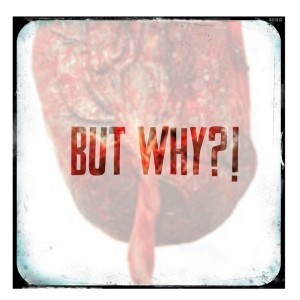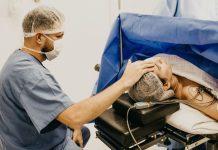 “You wanna WHAT your HUH?” said my sweet, traditional husband. “Eat my placentas,” I repeated, “like in a pill. People do it. It’s not weird.”
“You wanna WHAT your HUH?” said my sweet, traditional husband. “Eat my placentas,” I repeated, “like in a pill. People do it. It’s not weird.”
Surprisingly, he didn’t vomit on the spot, nor did he really ask any follow up questions. Just nodded. By that time in my pregnancy, he had experienced 7 months of emotional ups and downs from me, peppered with some crazy unexecuted ideas and plans (hello, natural childbirth for my giant twin boys, or painting our perfectly fine white cribs the faintest off white to exactly match the crib sheets.)
Me, the girl who can’t eat meat off a bone because I cringe. Me, the girl who forgets to take her vitamins regularly. Placental encapsulation was about as wild of an idea for me as not highlighting my hair during pregnancy.
 I first heard of placental encapsulation – the process by which a mother’s placenta is cooked or steamed, dehydrated, ground into a powder, and placed in pills for the mother’s consumption – from my best friend in Florida. The whole thing took place in her kitchen by a woman from a local birthing center, and she and her husband watched with wonder. She, like me, isn’t what some might call “earthy” or “crunchy” – just a mom-to-be that had done some research and figured it was worth a shot. The American Pregnancy Association states the following as “possible benefits,” while noting that these benefits aren’t scientifically proven – only backed up by anecdotal evidence.
I first heard of placental encapsulation – the process by which a mother’s placenta is cooked or steamed, dehydrated, ground into a powder, and placed in pills for the mother’s consumption – from my best friend in Florida. The whole thing took place in her kitchen by a woman from a local birthing center, and she and her husband watched with wonder. She, like me, isn’t what some might call “earthy” or “crunchy” – just a mom-to-be that had done some research and figured it was worth a shot. The American Pregnancy Association states the following as “possible benefits,” while noting that these benefits aren’t scientifically proven – only backed up by anecdotal evidence.
- An increase in the release of oxytocin, which encourages bonding and the shrinking of the uterus.
- An increase of CRH, a stress-reducing hormone.
- A decrease in postpartum depression levels.
- The restoration of iron levels in blood.
- An increase in milk production.
Sold. That all sounded wonderful, and for a relatively low cost (a heck of a lot cheaper than formula, belly bands, and mood stabilizing drugs!). So I made arrangements with an woman experienced in this field through a local birthing center where I received my weekly prenatal chiropractic adjustments. She would pick up the two placentas (one for each baby! Bonus!) and get to work. In a few short days after the boys were born, I would have my hands on my wonder pills. Easy breezy.
Not quite.
 Little did I know that I had entered a controversial and complicated world, one that many women face here in Texas when trying to follow their birth plans. To start, my hospital told me that it has a policy in place that prohibits the release of placentas after birth. Well, dang. Because of blood testing and a twin pregnancy, I was also told that my placentas would be treated with chemicals that would render them unable to be processed for encapsulation. Boo.
Little did I know that I had entered a controversial and complicated world, one that many women face here in Texas when trying to follow their birth plans. To start, my hospital told me that it has a policy in place that prohibits the release of placentas after birth. Well, dang. Because of blood testing and a twin pregnancy, I was also told that my placentas would be treated with chemicals that would render them unable to be processed for encapsulation. Boo.
After the rigors of a 37 week twin pregnancy, major abdominal surgery, and a hunger that no pudding pack or chicken broth could quench, I was in no shape to go through any red tape that might give me a teeny tiny chance of being able to go about my placenta business.
My contact at the birthing center told me I had some options to consider. I could call a funeral director to pick up the placentas at the hospital morgue and tell the staff at the hospital I wished to use the placentas in a religious ceremony. I could send my sweet husband to get a court order and give that a go. On my boys’ first day on Earth – a day filled with joy, promise, and awkward tandem nursing lessons – I just couldn’t imagine calling a funeral home. I also couldn’t imagine robbing my husband of those sweet and chaotic first moments as a family by sending him to the courthouse. Plus, who was going to grab my celebratory box of CheezIts once I got the all clear for solid foods? So I shrugged my shoulders and thought it was the first of many plans gone awry in new motherhood. Life goes on. Pass the CheezIts.
As months went by, I saw my milk production dwindle – despite pumping and nursing my two hungry boys day and night. I also, unfortunately, slid into some pretty rough postpartum depression and anxiety. Could things have been different for me if I would have been able to do as I intended? Was I robbed of my magic cure-all pill? People get to bring home their tonsils; why couldn’t I leave the hospital with this waaaay more useful souvenir?
I got mad. I found that I wasn’t alone.
A friend of mine posted on Facebook in the Spring that she was working with her local representative to bring forward legislation to give mothers legal rights to their placentas. She was met with the same resistance after her daughter’s birth, and began investigating the issue. It turns out that the fate of the placenta after its delivered was not clearly described by Texas law, and hospitals could interpret as they wish. Women who give birth at home or in birthing centers (more often than not) are able to do as they wish with their placentas — barring any blood-borne diseases.
My friend’s work paid off: Governor Abbott signed the bill into law this past June. The language of the bill states that all hospitals and birthing centers must release the placentas to the mother without a court order, and have until January 2016 to revise their protocol. Talk about moms making things happen!
With this hindrance aside, many more mothers may opt for placenta encapsulation. Many may still think it’s as gross and unproven as before. Either way, mothers now have a choice. That thing — the one that nourished your growing baby for nine months — might hold some comfort to new moms out there who are grasping for anything to ease their transition. It might not hold all the answers, or cure all postpartum issues, but deciding for ourselves is certainly worth busting open a celebratory box of CheezIts.















Great article!! For anyone who interested in more general information about the law, placenta traditions and uses, or how the law is being implemented please join our Facebook group Pass the Placenta on Facebook.
Amazing and inspirational! Love your stories